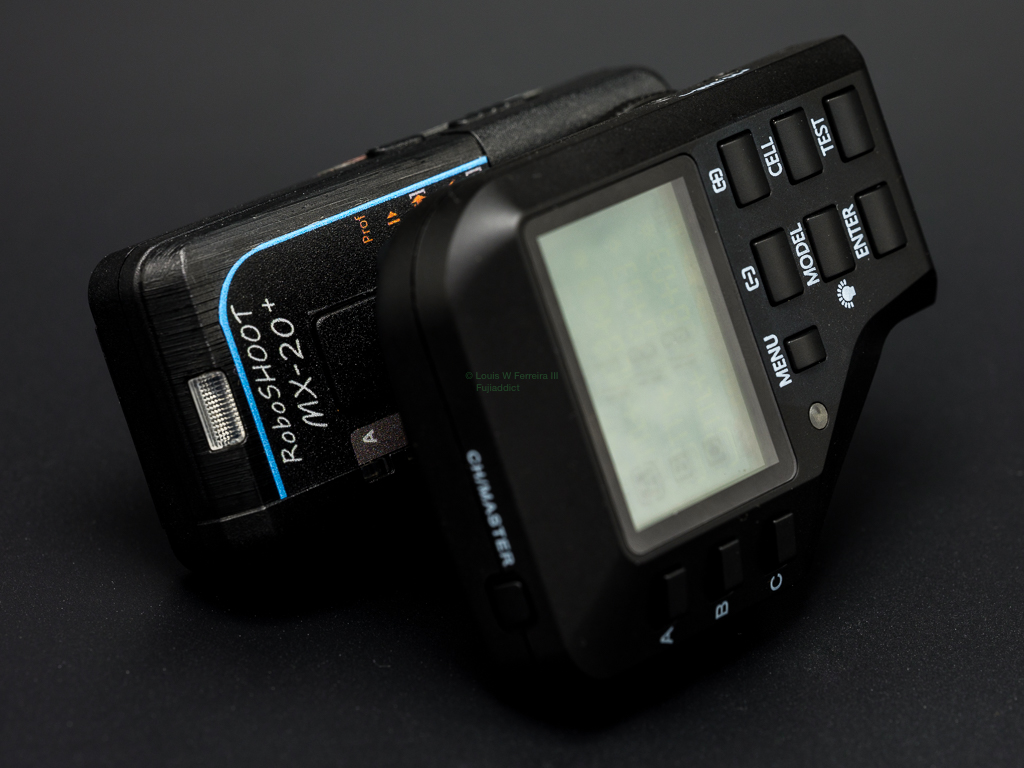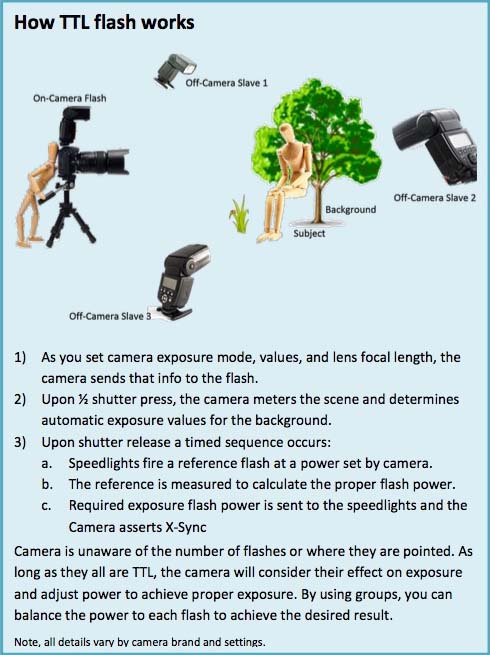
There are many types of flash triggers available with a variety of capabilities and price ranges. A good overview is at: http://dpanswers.com/content/radio_flash.php#ttlpt. That article mentions TTL Pass-through, among other topics, and often I get questions about this such as: “Is TTL pass-through important?” As is usually the case, the correct answer requires a lot more detail. To start, let’s define ‘advanced TTL’ to mean Camera controlled flash functions including TTL, HSS/AutoFP, exposure values, lens focal length, focus beam, and other information sent from camera to flash via digital signals.
Passing these ‘advanced TTL’ signals directly to the on-camera flash via the camera mounted trigger is referred to as ‘TTL pass-through’. This usually means the camera shoe signals are blindly passed from camera, through the trigger, to the flash. Unfortunately, for the photographer, TTL pass-through doesn’t do anything to provide ‘advanced TTL’ to the slaves, which is a significant omission since that is exactly what triggers are used for: controlling slaves! Yet, this doesn’t mean such devices are not capable. It simply means you should not expect TTL Off-Camera at the slaves.
Of course, it is conceivable the trigger could have TTL pass- through and still monitor those ‘advanced TTL’ signals and provide TTL to the slaves. But, because pass-through signals are uncontrolled by the trigger, the On-Camera flash cannot be a member of flash groups provided by that trigger. Setting group values with such an arrangement will not have any effect on the On-Camera flash. So, this is a negative for such triggers and a manufacturer of true TTL triggers probably wouldn’t want to brag about TTL pass-through if they employ it. It is also conceivable a trigger could interrupt the pass-through signals to manually control the On- Camera flash. This sounds nice on paper, but, since the flash is on camera it can easily be manually controlled already. What’s more, if this is done, this mode turns off the only TTL function available. So, why claim TTL in the first place?Thus, it turns out TTL pass-through is usually code for: ‘we don’t actually support TTL at all’. Furthermore, TTL pass-through is detrimental in most cases: having On-Camera TTL but manual Off-Camera will frequently negatively impact TTL metering, calling into question whether to have TTL On-Camera at all when only manual slaves are present. Of course, such an arrangement may be desirable in some cases, so, there are no absolutes. As always, it is the details that count. When you see TTL pass-through in a product spec, it may be you prefer manual and wish to limit yourself to manual control. Whereas, many TTL triggers allow you to choose TTL or manual as you like, on each group, individually. So, just be aware of both the capabilities and limitations of any trigger you consider.
Advanced TTL support is complex and requires sophisticated trigger device capabilities and this tends to be more expensive, so, a manufacturer may look for ways to imply TTL support without actually providing it. One consideration to keep in mind when you look at or read about triggers: some people refer to a trigger as having TTL pass-through even though the trigger may have true TTL. This is mainly due to the confusion of what pass-through actually is and what it implies.

There is a flash trigger product that proudly does NOT provide TTL pass-through. It is the RoboSHOOTplus from Serene Automation LLC, and it has true digital ‘advanced TTL’ everywhere, On-Camera and Off-Camera. So, EVERY flash at ANY location can:
- Be fully controlled via In-Camera menus
- Provide TTL, HSS, Manual, and other ‘advanced TTL’ capabilities
- Be assigned to a group and follow editable group profile values including mode, zoom,
- enable and more.
- Bracket on group profile values
- Follow lens focal length zoom (either exactly or a multiple of lens focal length)
- Provide protocol translation to support ‘advanced TTL’ on other flash brands
- Decode and use both old and new Fujifilm camera protocols
- Support Nikon studio strobes (and Fujifilm, when available) with HSS and TTL
- Operate entirely plug-n-play without needing to configure or learn flashes.
- Be controlled and customized via smartphone App
- And much more.
In the link mentioned at the beginning of this article, RoboSHOOTplus would be a type 5 ‘dedicated TTL Radio Trigger’. In fact, RoboSHOOTplus is the only product in the world that provides all the ‘advanced TTL’ functions listed above to multiple flash brands. And it is designed specifically for Fujifilm Cameras!
John Poremba is founder of Serene Automation LLC.
